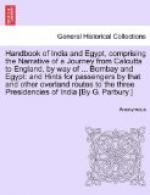Thus perhaps the legend of storm and shipwreck is not false, but records in poetic diction the arrival on these shores of men who presumably had in some degree inherited the genius of the most famous and most civilized country of prehistoric ages, and who had by long trafficking in dangerous waters and by the hardships of long migration acquired that self-reliance and love of mastery which has been bequeathed almost unchanged to their Brahmanised descendants. The Chitpavans were indeed the children of the storm, and something of the spirit of the storm lives in them still. Some trace is theirs of the old obstinacy which taught those pale ancestors to fight against insuperable forces until they were cast naked and broken upon the seashore. And peradventure the secret lesson of the ancient folk-tale is this, that the God of the Axe, despite the curse, is still at hand to help them along the path to new birth, provided always that their cause is fair, that they invoke not his aid for trivial or unjust ends, and that they have been truly purified in the pyres of affliction.
XV.
NUR JAN.
“The singer only sang the Joy of
Life,
For all too well, alas! the
singer knew,
How hard the daily toil, how keen the
strife,
How salt the falling tear,
the joys how few.”
“Nay, Saheb, I accept no money for my songs from you and your friend; for you have taken a kindly interest in me and my past history, and have shewn me the respect which my birth warrants, but which alas! my occupation hath made forfeit in the eyes of the world. But,—if you have found satisfaction in my singing, then write somewhat of me and of my Mimi to the paper, even as you did of Imtiazan, that thus your people—the people who know not the inner life of India may learn that I was not born amid the saringis and the bells, and that I, the singer, hide within my heart a life-long regret.”




